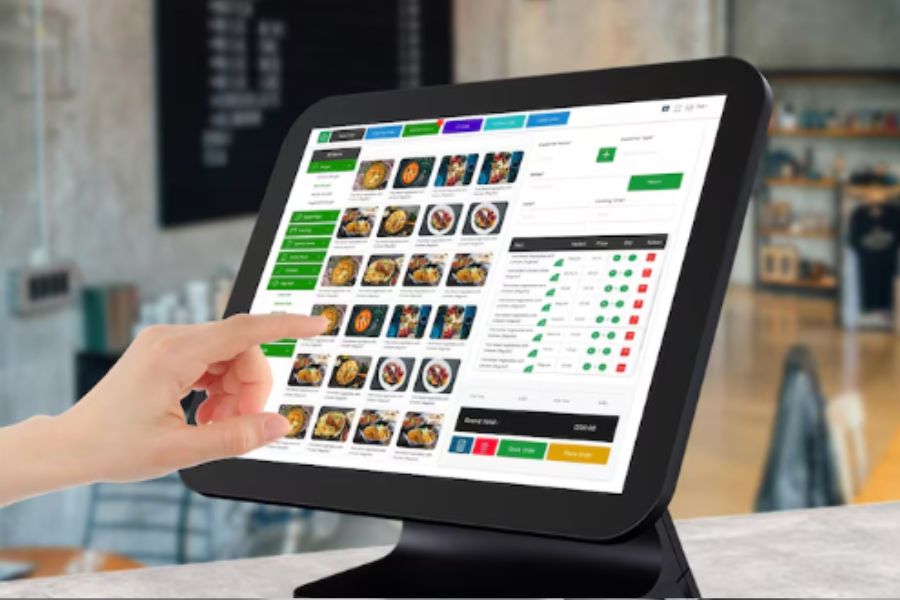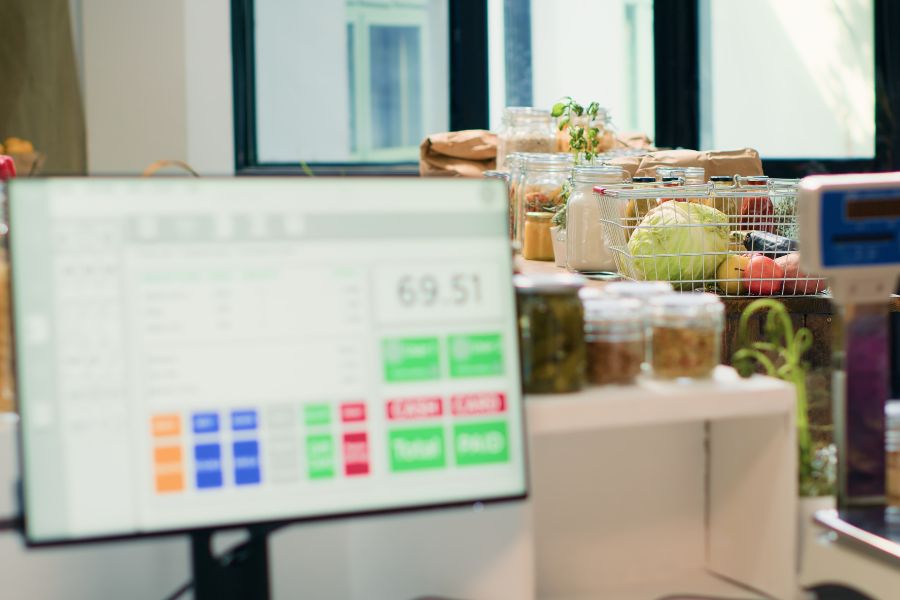In today’s fast-paced world, businesses are constantly seeking innovative solutions to streamline their operations and enhance the customer experience. One such solution that has gained significant traction is the self-service kiosk POS system.
In this blog, we delve into the intricacies of self-service kiosk POS system, exploring their key features, advantages, drawbacks, and best practices for implementation. Whether you’re a small business owner looking to boost sales or a large enterprise aiming to improve customer satisfaction, this ultimate guide will provide you with invaluable insights to make informed decisions and harness the full potential of self-service technology. Now, let’s get started!
What is a Self-service Kiosk POS System?
A self-service kiosk POS system provides customers with an interactive screen interface to purchase items or services independently without requiring staff assistance. This setup combines physical and digital components, enabling customers to browse products, place orders, and complete transactions on their own.
On the physical side, the kiosk typically features a fixed-screen device that is installed on surfaces such as walls, countertops, or free-standing pedestals. The digital aspect involves a specialized kiosk application that allows businesses to tailor the ordering process according to their specific requirements.
A common example of a self-service kiosk is a wall-mounted point-of-sale system found in retail stores or restaurants. These Kiosks empower customers to manage their purchases without the need for staff involvement.
Key Features of Self-service Kiosk POS System
Self-service kiosk POS systems offer a range of features designed to enhance the customer experience and streamline operations.
Here are some of the key features:
Self-service checkout
One of the primary features of self-service kiosk POS systems is the ability for customers to complete their transactions independently. After placing their orders and making payments, customers can proceed to self-checkout, eliminating the need for staff assistance and reducing waiting times.
User interface
The user interface of a self-service kiosk is designed to be intuitive and user-friendly, allowing customers to navigate through the ordering process with ease. Clear menus, large buttons, and visual cues help customers select items and customize their orders efficiently.
Safety measures
Self-service kiosks often incorporate safety measures to protect both customers and staff. This may include features such as contactless payment options, antimicrobial coatings on touchscreen surfaces, and regular cleaning protocols to maintain hygiene standards.
Payment options
Self-service systems support various payment methods to accommodate customer preferences. This includes cash, credit/debit cards, mobile wallets, and other digital payment solutions. Providing multiple payment options ensures convenience for customers and helps expedite the checkout process.
Order personalization
Self-service kiosks allow customers to personalize their orders according to their preferences. Whether it’s selecting toppings for a pizza, choosing condiments for a burger, or specifying dietary requirements, customers have the flexibility to tailor their orders to suit their tastes.
These features contribute to a seamless and efficient ordering process, ultimately improving customer satisfaction and increasing operational efficiency for businesses.
Advantages of Using Self-Service Kiosks in the Retail Industry
Self-service kiosks offer numerous advantages for retailers, enhancing various aspects of operations and customer experience.
Let’s explore some of the key benefits:
Enhanced resource utilization
Self-service kiosks enable retailers to optimize their human resources by automating routine tasks such as checkouts and product inquiries.
For example, deploying self-checkout kiosks allows retailers to redistribute staff to other areas of the store where their assistance may be more valuable, such as providing personalized customer service or restocking shelves.
Elevated customer satisfaction
Self-service kiosks empower customers with greater control over their shopping experience, leading to higher satisfaction levels.
With this feature, in a grocery store setting, self-checkout kiosks provide customers with the convenience of quick and hassle-free transactions, reducing wait times and enhancing overall satisfaction.
Increased scalability
Self-service kiosks enable retailers to scale their operations more efficiently to meet growing demand.
For example, a clothing retailer can quickly deploy additional fitting room kiosks during peak shopping seasons to accommodate increased foot traffic, without the need for significant investments in additional physical infrastructure.
Remote administration capability
One significant advantage of self-service kiosks is the ability to manage and update content, software, and configurations remotely.
This remote administration capability allows retailers to ensure consistent user experiences across all kiosks, troubleshoot issues efficiently, and implement updates or promotions in real time.
Enhanced profit margins
Self-service kiosks can contribute to improved profit margins by reducing overhead costs associated with traditional checkout methods.
With fewer staff needed for manual transactions, retailers can achieve cost savings while simultaneously increasing revenue through upselling opportunities and impulse purchases facilitated by the kiosks.
Heightened operational efficiency
By streamlining various retail processes, such as payments, product information retrieval, and order placement, self-service kiosks can significantly enhance operational efficiency.
This efficiency translates to faster transaction times, reduced queues, and overall smoother operations, ultimately benefiting both customers and retailers alike.
In sum, integrating self-service kiosks into the retail environment offers a multitude of benefits, ranging from improved resource utilization and customer satisfaction to increased scalability and profitability. As technology continues to advance, leveraging self-service solutions will likely become increasingly essential for retailers looking to stay competitive in today’s dynamic market.
Disadvantages of Using Self-Service Kiosks in the Retail Industry
While self-service kiosks offer numerous benefits, there are also some drawbacks that retailers should consider before implementing them.
Customer irritation
Self-service kiosks can sometimes lead to customer frustration or irritation, particularly when encountering technical issues or difficulties in navigating the interface. For example, if a kiosk’s touchscreen is unresponsive or if the menu options are unclear, customers may become impatient and dissatisfied with their shopping experience.
Additionally, some customers may prefer interacting with a human cashier, especially in situations where they have questions about products or need assistance with their transactions. The lack of immediate human interaction at self-service kiosks can leave customers feeling disconnected or unsupported, leading to negative perceptions of the brand or store.
Absence of personal engagement
Another downside of self-service kiosks is the absence of personal engagement between customers and retail staff. Human interaction plays a crucial role in building rapport and trust with customers, which can be difficult to achieve through self-service kiosks alone.
Furthermore, self-service kiosks lack the ability to provide personalized recommendations or assistance based on individual customer preferences. For example, a knowledgeable sales associate can offer tailored product suggestions or address specific customer needs, enhancing the overall shopping experience.
Periods of inactivity
Self-service kiosks may experience periods of inactivity, especially during off-peak hours or when there are fewer customers in the store. During these times, the presence of unused kiosks can detract from the overall aesthetic appeal of the retail environment and may represent underutilized resources.
Additionally, maintaining and servicing self-service kiosks requires ongoing investment in time and resources. If a kiosk malfunctions or requires maintenance, it can disrupt customers’ shopping experience and create an additional workload for store staff tasked with resolving the issue.
While self-service kiosks offer advantages such as convenience and efficiency, they also present challenges related to customer irritation, absence of personal engagement, and periods of inactivity. Retailers must carefully weigh the pros and cons before deciding whether to implement self-service kiosks in their stores.
Industries That Use Self-Service Kiosks
Self-service kiosks have become increasingly prevalent across various industries, transforming the way businesses interact with customers and manage operations. Let’s explore how different sectors utilize self-service kiosks to enhance efficiency, improve customer experiences, and drive innovation.
Retail
The retail industry has been at the forefront of adopting self-service kiosks to redefine the shopping experience. From self-checkout stations to interactive product catalogs, retailers leverage these kiosks to streamline transactions, reduce wait times, and empower customers with greater control over their shopping journey.
Self-service kiosks in retail environments offer benefits such as personalized recommendations, seamless integration with loyalty programs, and access to additional services, enhancing overall customer satisfaction and driving sales.
Moreover, retailers gain valuable insights into consumer behavior and preferences through data collected from self-service interactions, enabling them to make informed decisions and deliver targeted marketing strategies.
Healthcare
Not only retail, self-service kiosks have revolutionized the healthcare industry by optimizing administrative processes, enhancing patient experiences, and improving workflow efficiency. In hospitals, clinics, and medical offices, these kiosks facilitate patient check-in, appointment scheduling, payment processing, and updating personal information, reducing paperwork and wait times.
Self-service kiosks empower patients to manage their healthcare journey independently, improving satisfaction levels and freeing up staff to focus on delivering quality care.
Additionally, customizable features such as multilingual support and educational resources cater to diverse patient needs, fostering inclusivity and accessibility in healthcare settings. As healthcare continues to evolve digitally, self-service kiosks play a crucial role in modernizing operations and enhancing patient engagement.
Foodservice
In the food service industry, self-service kiosks are transforming the way customers order and interact with restaurants. These kiosks provide a convenient alternative to traditional counter service, allowing customers to browse menus, customize their orders, and make payments independently.
Moreover, self-service kiosks help reduce wait times during peak hours, improve order accuracy, and enhance the overall dining experience. Restaurants, fast-food chains, cafeterias, and other food establishments are implementing self-service kiosks to cater to changing consumer preferences and improve operational efficiency.
Additionally, self-service kiosks enable food service businesses to gather valuable data on customer preferences, order trends, and peak hours, which can be used to optimize menu offerings, staffing levels, and marketing strategies.
Travel & Hospitality
The travel and hospitality industry has embraced self-service kiosks as a means to enhance customer service and streamline processes. Airports, hotels, rental car agencies, and other travel-related businesses utilize self-service kiosks to expedite check-in, automate baggage handling, and provide interactive wayfinding assistance.
For travelers, self-service kiosks offer convenience, flexibility, and reduced waiting times, especially during peak travel seasons. By empowering customers to complete routine tasks independently, such as printing boarding passes or accessing room keys, self-service kiosks contribute to a seamless and efficient travel experience.
Financial
In the financial sector, self-service kiosks play a vital role in delivering convenient and accessible banking services to customers. Banks, credit unions, and financial institutions deploy self-service kiosks to offer a range of transactions, including cash deposits, withdrawals, account transfers, and bill payments.
These kiosks provide customers with 24/7 access to basic banking services, regardless of branch operating hours, thereby enhancing convenience and accessibility. Moreover, self-service kiosks in the financial industry help reduce operational costs associated with traditional brick-and-mortar branches, such as staffing expenses and facility maintenance.
Best Practices for Implementing Self-Service Kiosk POS Systems
Implementing self-service kiosk POS systems can significantly enhance customer experience and operational efficiency for businesses. To ensure successful deployment, several best practices should be followed:
Deploy Self-Service Kiosks by Identifying Your Requirements
Before implementing self-service kiosks, it’s essential to identify specific business requirements and customer needs. Conduct thorough research to understand your target audience, their preferences, and pain points.
For example, if you run a fast-food restaurant, consider whether customers prefer customizable options or quick, preset menu selections. Additionally, assess operational needs such as order processing speed, payment options, and integration with existing POS systems.
Select the Appropriate POS System for Self-Service Kiosk Implementation
Choosing the right POS system is crucial for the successful implementation of self-service kiosks. Evaluate POS systems based on factors such as functionality, reliability, scalability, and compatibility with self-service kiosk hardware.
For example, a cloud-based POS system offers real-time data access and seamless integration with self-service kiosks, enabling centralized management and reporting.
Furthermore, consider features specific to self-service kiosk operations, such as intuitive user interfaces, secure payment processing, and robust data analytics capabilities. A self-service kiosk POS system with built-in inventory management and customer relationship management (CRM) functionalities can provide valuable insights for business decision-making and customer engagement strategies.
Incorporate Self-Service Kiosks into the Omnichannel Experience
Integrating self-service kiosks into the omnichannel experience allows businesses to provide seamless interactions across multiple touchpoints, including online, mobile, and in-store channels.
For example, a retailer can enable customers to browse products, check inventory, and make purchases via self-service kiosks, with options for in-store pickup or home delivery. Also, self-service kiosks can serve as self-service ordering stations for online orders, enabling customers to pick up their items conveniently in-store.
Opt for Strategic Locations for Self-Service Kiosks
Strategically placing self-service kiosks in high-traffic areas can maximize their visibility and accessibility to customers. Conduct thorough site surveys and analyze foot traffic patterns to identify optimal locations for self-service kiosk deployment. For example, place self-service kiosks near entranceways, checkout lanes, or busy corridors to capture the attention of passing customers and encourage usage.
Additionally, consider the layout and design of the physical space when positioning self-service kiosks. Ensure adequate space and accessibility for customers to interact with the kiosks comfortably.
For instance, avoid placing self-service kiosks in congested or cluttered areas that may hinder user experience. By selecting strategic locations for self-service kiosks, businesses can increase customer engagement, streamline operations, and drive sales effectively.
Design Self-Service Kiosks and Strategize Your Launch
Designing self-service kiosks with user-friendly interfaces and intuitive navigation is essential to ensure a positive customer experience. Collaborate with designers and usability experts to create visually appealing kiosk layouts, clear menu structures, and easy-to-understand instructions.
For example, use high-resolution graphics, color-coded buttons, and descriptive labels to guide customers through the ordering process seamlessly.
Furthermore, plan a comprehensive launch strategy to promote awareness and adoption of self-service kiosks among customers. Implement marketing initiatives such as signage, digital promotions, and in-store demonstrations to highlight the benefits of using self-service kiosks.
Train staff members to assist customers with kiosk usage and effectively address any questions or concerns. By thoughtfully designing self-service kiosks and strategizing their launch, businesses can ensure a successful rollout and drive engagement with the new self-service solution.
FAQs: Self-service Kiosk POS System
- Are self-service kiosks secure for processing payments?
These kiosks utilize sophisticated security measures, such as encrypted transactions, secure network connections, and adherence to Payment Card Industry Data Security Standards (PCI DSS). Consistent software updates and maintenance are essential for safeguarding against emerging threats.
- Can self-service kiosks accommodate special dietary requirements?
Yes, self-service kiosks can be designed to accommodate special dietary requirements. These kiosks can offer options for various dietary restrictions such as gluten-free, vegan, vegetarian, nut-free, or dairy-free meals. They can provide customizable menus where customers can select their preferences or dietary restrictions, and the kiosk can then suggest suitable meal options accordingly.
Additionally, some self-service kiosks may also offer allergen information for each menu item to help customers make informed choices based on their dietary needs.
- Do self-service kiosks require an internet connection to function?
Yes, self-service kiosks typically require an internet connection to function efficiently. While some basic functions may still operate without internet access, such as displaying static information or processing simple transactions, many of the advanced features rely on an internet connection. These include real-time updates to menus or pricing, processing credit card transactions, accessing cloud-based data and analytics, and remotely managing multiple kiosks from a central location.
Wrap Up
In sum, self-service kiosk POS systems offer a multitude of features and benefits that can greatly enhance the efficiency and customer experience in various industries such as retail, hospitality, and healthcare. With their intuitive interfaces, customization options, and ability to streamline transactions, self-service kiosks empower businesses to improve operational efficiency, reduce wait times, and increase customer satisfaction.
If you want to know moreself-service kiosk POS system, feel free to contact us.



